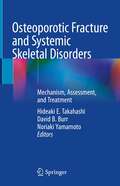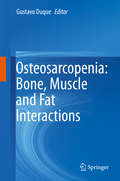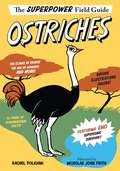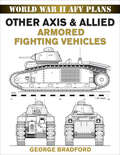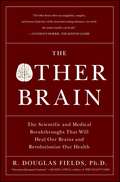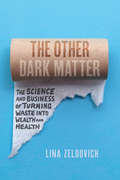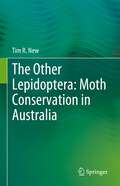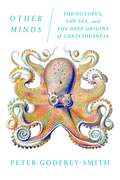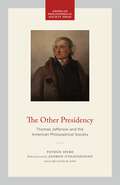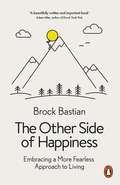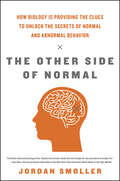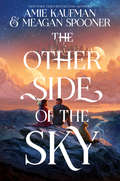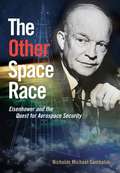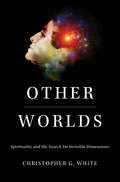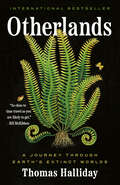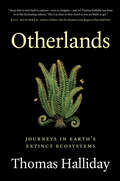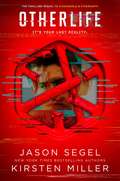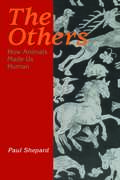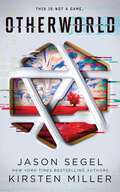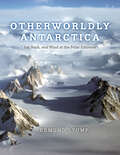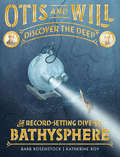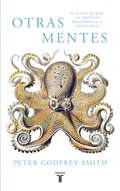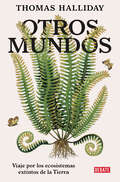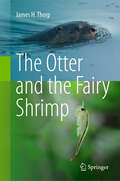- Table View
- List View
Osteoporotic Fracture and Systemic Skeletal Disorders: Mechanism, Assessment, and Treatment
by Hideaki E. Takahashi David B. Burr Noriaki YamamotoThis edited book describes what fragile bone is, how the condition is assessed, and how it can be treated. It is intended for multi-professional trainees and practitioners in health and social care fields who care for and treat the elderly.Chapters within the book provide the latest advances in cell and molecular biology, morphology, radiology, and the biomechanics of bone in health and disease. The basic concept of “Remodeling” and “Modeling” is described for better understanding of the mechanisms of osteoporosis. Methods of identifying and assessing osteoporosis are described, as are risk factors for bone fracture and non-unions. Furthermore, the effects of various drugs used to treat osteoporosis at both material and structural levels of bone and their cost effectiveness are described. Operative treatments for fracture that maintain or improve the quality of life of patients are includedTreatment of Osteoporotic Fracture and Systemic Skeletal Disorders attempts to provide a holistic and translational view of the pathogenesis and treatment of osteoporosis and some other musculoskeletal diseases, with an overview of treatment modalities in various clinical settings.
Osteosarcopenia: Bone, Muscle and Fat Interactions
by Gustavo DuqueThis edited work presents the most current evidence on osteosarcopenia from bench to bedside, which is expected to facilitate the understanding of this syndrome and to develop preventive and therapeutic strategies. With our aging population, chronic diseases such as osteoporosis and sarcopenia are becoming highly prevalent. Fortunately, our understanding of the bone and muscle interactions has increased in recent years. This has allowed to the coining of the term osteosarcopenia to describe a syndrome in which these two diseases overlap. This overlap between osteoporosis and sarcopenia has major negative effects not only on our older adults but also on health systems worldwide. Readers will find a highly translational approach that starts with a summary of recent discoveries on stem cells biology, muscle and bone interactions – including the role of local bone and muscle fat – followed by comprehensive reviews on myokines (i.e. myostatin), osteokines (i.e. osteocalcin) and adipokines (i.e. interleukins) as major players and determinants of bone and muscle loss with aging. In addition, the role of sex steroids (i.e. estrogens, androgens), and calciotropic hormones (i.e. parathyroid hormone, vitamin D) in the pathogenesis of this syndrome is also reviewed. Moreover, using practical diagnostic and therapeutic tips, this book summarizes the clinical characteristics of osteosarcopenic patients thus facilitating the diagnosis and treatment of this syndrome in clinical practice. Finally, the book presents the case for the Falls and Fractures Clinic as the optimal model of care for this syndrome, aimed to avoid fragmentation and optimize osteosarcopenia care, and simultaneously prevent falls and fractures in older persons.This book offers relevant information on the mechanisms of osteosarcopenia, and a practical guide on how to identify and treat this geriatric syndrome and its adverse outcomes, which are dramatically affecting our aging population.The work is written by leaders in the field and is especially suited not only to any researcher in the musculoskeletal arena but also to medical specialists and allied health professionals involved in the care of older persons.
Ostriches (Superpower Field Guide)
by Rachel PoliquinThis third installment in the hilarious and highly-illustrated full-color Superpower Field Guide series features the silly-looking, surprisingly fierce Ostrich. This two-toed torpedo may have the largest eyes of any animal on dry land, but it can outrun most horses! Meet Eno, an ordinary ostrich living in the Serengeti, a corner of the African savanna. But there's something you should know: Even ordinary ostriches are extraordinary. And that includes Eno. I know what you&’re thinking. You&’re thinking that ostriches are just overgrown chickens with ridiculous necks, skinny legs, and bad attitudes. And you&’re right! Believe it or not, that neck helps ostriches run at supersonic speeds. Those skinny legs can kill a lion dead. And these are only a few weapons in Eno's arsenal of superfierce survival skills—Eno has Colossal Orbs of Telescopic Vision, the Impossible Ever-Flow Lung, the Egg of Wonder, and so many more. You&’re still not convinced that ostriches are superpowered, are you? Well, you don&’t know ostriches yet. But you will.
Other Axis & Allied Armored Fighting Vehicles: World War II AFV Plans (AFV Plans)
by George BradfordThis fully illustrated volume presents an authoritative and highly detailed study of WWII&’s lesser-known armored fighting vehicles. The iconic tanks of WWII, such as America&’s Shermans and the Germany&’s Panzers, have been exhaustively studied. In Other Axis & Allied Armored Fighting Vehicles, military historian and technical artist George Bradford offers an in-depth look at a range of significant yet often-overlooked models. This volume is filled with fine-scale drawings of Australian, Belgian, Canadian, Czech, French, Hungarian, Italian, Japanese, Polish, Romanian, and South African armored vehicles, including: · Centauro Tank Destroyer (Italy) · TKS Light Reconnaissance Tank (Poland) · Ram &“Kangaroo&” Personnel Carrier (Canada) · Renault R-35 Light Tank (France) · Type 3 Chi-nu Heavy Tank (Japan) · Scorpion AC1 Cruiser Tank (Australia) · TACAM R-2 Tank Hunter (Romania) · And many, many more . . .
The Other Brain: From Dementia to Schizophrenia, How New Discoveries about the Brain Are Revolutionizing Medicine and Science
by R. Douglas FieldsDespite everything that has been written about the brain, a potentially critical part of this vital organ has been overlooked—until now. The Other Brain examines the growing importance of glia, which make up approximately 85 percent of the cells in the brain, and the role they play in how the brain functions, malfunctions, and heals itself. Long neglected as little more than cerebral packing material, glia (meaning “glue”) are now known to regulate the flow of information between neurons and to repair the brain and spinal cord after injury and stroke. But scientists are also discovering that diseased and damaged glia play a significant role in psychiatric illnesses such as schizophrenia and depression, and in neurodegenerative diseases such as Parkinson’s and Alzheimer’s. Diseased glia cause brain cancer and multiple sclerosis and are linked to infectious diseases such as HIV and prion disease (mad cow disease, for example) and to chronic pain. The more we learn about these cells that make up the “other” brain, the more important they seem to be. Written by a neuroscientist who is a leader in glial research, The Other Brain gives readers a much more complete understanding of how the brain works and an intriguing look at potentially revolutionary developments in brain science and medicine.
The Other Dark Matter: The Science and Business of Turning Waste into Wealth and Health
by Lina ZeldovichGrossly ambitious and rooted in scientific scholarship, The Other Dark Matter shows how human excrement can be a life-saving, money-making resource—if we make better use of it. The average person produces about four hundred pounds of excrement a year. More than seven billion people live on this planet. Holy crap! Because of the diseases it spreads, we have learned to distance ourselves from our waste, but the long line of engineering marvels we’ve created to do so—from Roman sewage systems and medieval latrines to the immense, computerized treatment plants we use today—has also done considerable damage to the earth’s ecology. Now scientists tell us: we’ve been wasting our waste. When recycled correctly, this resource, cheap and widely available, can be converted into a sustainable energy source, act as an organic fertilizer, provide effective medicinal therapy for antibiotic-resistant bacterial infection, and much more. In clear and engaging prose that draws on her extensive research and interviews, Lina Zeldovich documents the massive redistribution of nutrients and sanitation inequities across the globe. She profiles the pioneers of poop upcycling, from startups in African villages to innovators in American cities that convert sewage into fertilizer, biogas, crude oil, and even life-saving medicine. She breaks taboos surrounding sewage disposal and shows how hygienic waste repurposing can help battle climate change, reduce acid rain, and eliminate toxic algal blooms. Ultimately, she implores us to use our innate organic power for the greater good. Don’t just sit there and let it go to waste.
The Other Lepidoptera: Moth Conservation in Australia
by Tim R. NewConservation interest in moths, by far the predominant components of Lepidoptera, lags far behind that for butterflies, for which conservation practice provides many well-established lessons for extension to their near relatives. The needs of moths are at least as great, but their greater richness and variety, and far poorer documentation of diversity and biology over much of the world contribute to this lack of attention. Australia’s rich moth fauna, largely endemic and of global interest, illustrates many of the problems of developing wider interest and support for moth conservation. Numerous species (perhaps half the total fauna) are undescribed, and many are ecological specialists in restricted and vulnerable environments over small parts of the continent. Establishing their conservation status and needs whilst accepting that foundation knowledge is highly incomplete and much species-focused conservation is impracticable provides complex problems in setting priorities, based largely on wider diversity and effective advocacy. Most Australian vegetation systems, from grassland to forest and from sea-level to alpine zones, have been eroded in extent and quality since European settlement, resulting in massive habitat changes for native insects and to leave fragmented (and commonly degraded) remnants in which moths and others may persist. Recent surveys continue to increase recorded moth richness, reveal local faunal peculiarities, and indicate how assemblage changes may mirror wider environmental changes. This book is an overview of advances in documenting and interpreting moth diversity and ecology, to show how information from better-studied moth faunas can help in planning conservation of Australia’s moths through measures such as understanding the moths themselves by increased surveys and study, the factors influencing their diversity and wellbeing, and how such threats may be countered through increased coordinated conservation interest, commitment and management.
Other Minds: The Octopus, the Sea, and the Deep Origins of Consciousness
by Peter Godfrey-SmithAlthough mammals and birds are widely regarded as the smartest creatures on earth, it has lately become clear that a very distant branch of the tree of life has also sprouted higher intelligence: the cephalopods, consisting of the squid, the cuttlefish, and above all the octopus. In captivity, octopuses have been known to identify individual human keepers, raid neighboring tanks for food, turn off lightbulbs by spouting jets of water, plug drains, and make daring escapes. How is it that a creature with such gifts evolved through an evolutionary lineage so radically distant from our own? What does it mean that evolution built minds not once but at least twice? The octopus is the closest we will come to meeting an intelligent alien. What can we learn from the encounter? <P><P>In Other Minds, Peter Godfrey-Smith, a distinguished philosopher of science and a skilled scuba diver, tells a bold new story of how subjective experience crept into being―how nature became aware of itself. As Godfrey-Smith stresses, it is a story that largely occurs in the ocean, where animals first appeared. Tracking the mind’s fitful development, Godfrey-Smith shows how unruly clumps of seaborne cells began living together and became capable of sensing, acting, and signaling. As these primitive organisms became more entangled with others, they grew more complicated. The first nervous systems evolved, probably in ancient relatives of jellyfish; later on, the cephalopods, which began as inconspicuous mollusks, abandoned their shells and rose above the ocean floor, searching for prey and acquiring the greater intelligence needed to do so. Taking an independent route, mammals and birds later began their own evolutionary journeys. <P><P>But what kind of intelligence do cephalopods possess? Drawing on the latest scientific research and his own scuba-diving adventures, Godfrey-Smith probes the many mysteries that surround the lineage. How did the octopus, a solitary creature with little social life, become so smart? What is it like to have eight tentacles that are so packed with neurons that they virtually “think for themselves”? What happens when some octopuses abandon their hermit-like ways and congregate, as they do in a unique location off the coast of Australia? <P><P>By tracing the question of inner life back to its roots and comparing human beings with our most remarkable animal relatives, Godfrey-Smith casts crucial new light on the octopus mind―and on our own.
The Other Presidency: Thomas Jefferson and the American Philosophical Society
by Patrick SperoIn The Other Presidency, Patrick Spero resurrects an overlooked but essential part of Thomas Jefferson’s life. For nearly seventeen years, Jefferson served as President of the American Philosophical Society (APS), the nation’s first learned society and one dedicated to promoting new research in the young republic, especially in the sciences. He did so while also serving as Vice President and President of the United States. As Spero shows in this short but important work, Jefferson used his various positions to solidify the Society’s foundation and, in turn, shape the course of American science. Through a deep dive into APS Archives and Jefferson’s papers, Spero demonstrates how the Society became a thoroughly Jeffersonian institution—that is, the APS, the largest and most powerful scientific body in the nation, advanced an agenda that comported with Jefferson’s own priorities. While Jefferson juggled affairs of state, he also remained deeply involved in the Society. In fact, the two complemented each other. He helped draft the institution’s first collection development policy, making clear the items and material he thought most important for the nation’s posterity. He also used his international network to introduce European intellectuals to the Society, and he called on these same networks to help build the Society’s collection. Jefferson himself received direct support from the Society to conduct his own research, including funding for an expedition with James Madison, and as President of the United States, he would often call on the APS and its members for advice. In short, Spero shows that Jefferson was integral to the development of the APS—and, perhaps more unexpectedly, the APS and the scientific community it fostered were integral to Jefferson and his vision for the young United States.A resource for students, history buffs, and Jefferson aficionados, the book includes a chronology of Thomas Jefferson's contributions to the APS, with references to major events in Jefferson's life.
Other Senses, Other Worlds
by Doris Jonas David JonasScientific evidence now substantiates science fiction fantasies: we will meet alien beings on other planets--possibly in our own solar system, surely in other galaxies. What shapes will they take? What kinds of intelligence can we expect? How will we communicate? Here two scientists provide authoritative speculation on the nature of extra-terrestrial life, beginning their investigation with a survey of sensory perception on earth--not just our five senses, but the senses we lack that are found in other forms of life. Based on accepted facts about the environments of other planets they have created fascinating and indeed probable scenarios for a whole range of other worlds, complete with intelligent life forms, social structures, and life-styles.
The Other Side of Happiness: Embracing a More Fearless Approach to Living
by Dr. Brock Bastian'Required reading ... Brock Bastian expertly picks apart the fundamental idea that humans thrive when they approach pleasure and avoid pain, explaining why hardship sometimes yields richer lives that are laden with meaning, deep social connections, and unexpected bliss' Adam Alter, author of Drunk Tank Pink In today's culture, happiness has become the new marker of success, while hardships are viewed as personal weaknesses, or problems to be fixed. We increasingly try to eradicate pain through medication and by insulating ourselves from risk and offence, despite being the safest generation to have ever lived. Yet in his research, renowned social psychologist Brock Bastian has found that suffering and sadness are neither antithetical to happiness nor incidental to it: they are a necessary ingredient for emotional well-being.Drawing on psychology, neuroscience and internationally acclaimed findings from Bastian's own lab, The Other Side of Happiness encourages us to take a more fearless approach to living. The most thrilling moments of our lives are often balanced on a knife edge between pleasure and pain, whether it is finding your true love, holding your new-born for the first time, finishing a marathon or even plunging into an icy sea. This is because pain and the threat of loss quite literally increase our capacity for happiness, as Bastian reveals, making us stronger, more resilient, more connected to other people and more attuned to what truly matters. Pain even makes us more mindful, since in our darkest moments we are especially focused and aware of the world around us. Our addiction to positivity and the pursuit of pleasure is actually making us miserable. Brock Bastian shows that, without some pain, we have no real way to achieve and appreciate the kind of happiness that is true and transcendent.
The Other Side of Normal: How Biology Is Providing the Clues to Unlock the Secrets of Normal and Abnormal Behavior
by Jordan SmollerPsychiatry has ignored the normal. The focus on defining abnormal behavior has obscured what turns out to be a more fundamental question—how does the biology of the brain give rise to the mind, which in turn gives rise to everything we care about: thoughts, feelings, desires, and relationships? In The Other Side of Normal, Harvard psychiatrist Jordan Smoller shows us that understanding what the mind was designed to do in the first place demystifies mental illness and builds a new foundation for defining psychiatric disorders—from autism to depression. Smoller argues there are no bright lines between normal and abnormal. Psychiatric disorders are variations of the same brain systems that evolved to help us solve the challenges of everyday life. How do we become who we are? Smoller explains where our personalities come from, and how the temperaments we had as infants actually stay with us into adulthood. Why do we choose to date, love, and marry the people we do? Why do some of us form healthy relationships while others form unstable ones? Our relationships are shaped by the biology that drives two imperatives: maternal-child bonding and child-parent attachment. Along the way, Smoller tackles an even greater question—what do we mean by "normal"?—as he explores the puzzles behind the epidemics of multiple personalities and koro, the shocking phobia that one's penis is shrinking. He also looks at the controversial history of psychiatric classification and the explosive debates over how much early experiences influence our minds and to what degree genetics affect our temperaments, personalities, and emotional lives. Throughout this examination, Smoller explores the hidden sides of such questions as: How are trust and love rooted in biology? How much does sexual attraction stem from biology rather than culture? And what can the scientific study of normal behavior tell us about what it means to be human?Based on the author's groundbreaking research and personal experiences treating psychological disorders, The Other Side of Normal changes the way we think about the human condition.
The Other Side of the Sky
by Amie Kaufman Meagan SpoonerNew York Times bestselling author duo Amie Kaufman and Meagan Spooner have crafted a gripping tale of magic and logic, fate and choice, and a deadly love. Perfect for fans of Laini Taylor and Brandon Sanderson. Prince North’s home is in the sky, in a gleaming city held aloft by intricate engines, powered by technology. Nimh is the living goddess of her people on the Surface, responsible for providing answers, direction—hope. North’s and Nimh’s lives are entwined—though their hearts can never be. Linked by a terrifying prophecy and caught between duty and fate, they must choose between saving their people or succumbing to the bond that is forbidden between them.
The Other Space Race: Eisenhower And The Quest For Aerospace Security
by Nicholas Michael SambalukThe Other Space Race is a unique look at the early U. S. space program and how it both shaped and was shaped by politics during the Cold War. Eisenhower’s "New Look” expanded the role of the Air Force in national security, and ultimately allowed ambitious aerospace projects, namely the "Dyna-Soar,” a bomber equipped with nuclear weapons that would operate in space. Eisenhower’s space policy was purely practical, creating a strong deterrent against the use of nuclear arms against the United States. With the Soviet launch of Sputnik in 1957, the political climate changed, and space travel became part of the United States’ national discourse. Sambaluk explores what followed, including the scuttling of the "Dyna-Soar” program and the transition from Eisenhower’s space policy to John Kennedy’s. This well-argued, well-researched book gives much needed perspective on the Cold War’s influence on space travel and it’s relation to the formation of public policy.
Other Worlds: Spirituality and the Search for Invisible Dimensions
by Christopher G. WhiteWhat do modern multiverse theories and spiritualist séances have in common? Not much, it would seem. One is an elaborate scientific theory developed by the world’s most talented physicists. The other is a spiritual practice widely thought of as backward, the product of a mystical world view fading under the modern scientific gaze. But Christopher G. White sees striking similarities. He does not claim that séances or other spiritual practices are science. Yet he points to ways that both spiritual practices and scientific speculation about multiverses and invisible dimensions are efforts to peer into the hidden elements and even the existential meaning of the universe. Other Worlds examines how the idea that the universe has multiple, invisible dimensions has inspired science fiction, fantasy novels, films, modern art, and all manner of spiritual thought reaching well beyond the realm of formal religion. Drawing on a range of international archives, White analyzes how writers, artists, filmmakers, televangelists, and others have used the scientific idea of invisible dimensions to make supernatural phenomena such as ghosts and miracles seem more reasonable and make spiritual beliefs possible again for themselves and others. Many regard scientific ideas as disenchanting and secularizing, but Other Worlds shows that these ideas—creatively appropriated in such popular forms as C. S. Lewis’s Chronicles of Narnia, the art of Salvador Dalí, or the books of the counterculture physicist “Dr. Quantum”—restore a sense that the world is greater than anything our eyes can see, helping to forge an unexpected kind of spirituality.
Otherlands: A Journey Through Earth's Extinct Worlds
by Thomas HallidayThe past is past, but it does leave clues, and Thomas Halliday has used cutting-edge science to decipher them more completely than ever before. In Otherlands, Halliday makes sixteen fossil sites burst to life on the page. <p><p> This book is an exploration of the Earth as it used to exist, the changes that have occurred during its history, and the ways that life has found to adapt―or not. It takes us from the savannahs of Pliocene Kenya to watch a python chase a group of australopithecines into an acacia tree; to a cliff overlooking the salt pans of the empty basin of what will be the Mediterranean Sea just as water from the Miocene Atlantic Ocean spills in; into the tropical forests of Eocene Antarctica; and under the shallow pools of Ediacaran Australia, where we glimpse the first microbial life. <p><p> Otherlands also offers us a vast perspective on the current state of the planet. The thought that something as vast as the Great Barrier Reef, for example, with all its vibrant diversity, might one day soon be gone sounds improbable. But the fossil record shows us that this sort of wholesale change is not only possible but has repeatedly happened throughout Earth history. Even as he operates on this broad canvas, Halliday brings us up close to the intricate relationships that defined these lost worlds. <p><p> In novelistic prose that belies the breadth of his research, he illustrates how ecosystems are formed; how species die out and are replaced; and how species migrate, adapt, and collaborate. It is a breathtaking achievement: a surprisingly emotional narrative about the persistence of life, the fragility of seemingly permanent ecosystems, and the scope of deep time, all of which have something to tell us about our current crisis.
Otherlands: Journeys in Earth's Extinct Ecosystems
by Thomas HallidaySapiens for natural history: a stirring, eye-opening journey into deep time, from the Ice Age to the first appearance of microbial life 550 million years ago, by a brilliant young paleobiologist.The past is past, but it does leave clues, and Thomas Halliday has used cutting-edge science to decipher them more completely than ever before. In Otherlands, Halliday makes sixteen fossil sites burst to life on the page.This book is an exploration of the Earth as it used to exist, the changes that have occurred during its history, and the ways that life has found to adapt-or not. It takes us from the savannahs of Pliocene Kenya to watch a python chase a group of australopithecines into an acacia tree; to a cliff overlooking the salt pans of the empty basin of what will be the Mediterranean Sea just as water from the Miocene Atlantic Ocean spills in; into the tropical forests of Eocene Antarctica; and under the shallow pools of Ediacaran Australia, where we glimpse the first microbial life. Otherlands also offers us a vast perspective on the current state of the planet. The thought that something as vast as the Great Barrier Reef, for example, with all its vibrant diversity, might one day soon be gone sounds improbable. But the fossil record shows us that this sort of wholesale change is not only possible but has repeatedly happened throughout Earth history.Even as he operates on this broad canvas, Halliday brings us up close to the intricate relationships that defined these lost worlds. In novelistic prose that belies the breadth of his research, he illustrates how ecosystems are formed; how species die out and are replaced; and how species migrate, adapt, and collaborate. It is a breathtaking achievement: a surprisingly emotional narrative about the persistence of life, the fragility of seemingly permanent ecosystems, and the scope of deep time, all of which have something to tell us about our current crisis.
OtherLife: Last Reality Series
by Jason Segel Kirsten MillerThe eagerly anticipated third instalment in the fast-paced Last Reality series Simon, Kat, Busara, and Elvis are on the run with the tech super-villains at the Company hot on their heels. The new VR gaming experience the Company created, OtherEarth, is set to change how the world experiences video games. Paired with the hardware the Company developed, it has the potential to change the world as we know it, altering our reality forever. The Company is on its way to becoming the world's newest superpower. And Simon is determined to shut them down forever. But to do that, he'll have to survive OtherLife – the next phase of gaming, and a complete reality reboot.
The Others: How Animals Made Us Human
by Paul ShepardPaul Shepard has been one of the most brilliant and original thinkers in the field of human evolution and ecology for more than forty years. His thought-provoking ideas on the role of animals in human thought, dreams, personal identity, and other psychological and religious contexts have been presented in a series of seminal writings, including Thinking Animals, The Tender Carnivore and the Sacred Game, and now The Others, his most eloquent book to date.The Others is a fascinating and wide-ranging examination of how diverse cultures have thought about, reacted to, and interacted with animals. Shepard argues that humans evolved watching other animal species, participating in their world, suffering them as parasites, wearing their feathers and skins, and making tools of their bones and antlers. For millennia, we have communicated their significance by dancing, sculpting, performing, imaging, narrating, and thinking them. The human species cannot be fully itself without these others.Shepard considers animals as others in a world where otherness of all kinds is in danger, and in which otherness is essential to the discovery of the true self. We must understand what to make of our encounters with animals, because as we prosper they vanish, and ultimately our prosperity may amount to nothing without them.
Otherworld: Last Reality Series (Last Reality Ser. #1)
by Jason Segel Kirsten Miller"Full of high stakes, thrillers, and fantastic twists and turns, fans of Ready Player One are sure to love this addictive read." —BUZZFEED Welcome to real life 2.0. Are you ready to play? There are no screens. There are no controls. You don&’t just see and hear it – you taste, smell, and touch it too. In this new reality there are no rules to follow, no laws to break. You can live your best life. It&’s a game so addictive you&’ll never want it to end. Until you realize that you&’re the one being played. Step into Otherworld. Leave your body behind. The frightening future that Jason Segel and Kirsten Miller have imagined is not far away. Otherworld asks the question we'll all soon be asking: if technology can deliver everything we want, how much are we willing to pay?
Otherworldly Antarctica: Ice, Rock, and Wind at the Polar Extreme
by Edmund StumpWith stunning original photographs, an Antarctic scientist and explorer takes us to one of the most sublime, remote, and pristine regions on the planet. The interior of Antarctica is an utterly pristine wilderness, a desolate landscape of ice, wind, and rock; a landscape so unfamiliar as to seem of another world. This place has been known to only a handful of early explorers and the few scientists fortunate enough to have worked there. Edmund Stump is one of the lucky few. Having climbed, photographed, and studied more of the continent-spanning Transantarctic Mountains than any other person on Earth, this geologist, writer, and photographer is uniquely suited to share these alien sights. With stories of Stump’s forty years of journeys and science, Otherworldly Antarctica contains 130 original color photographs, complemented by watercolors and sketches by artist Marlene Hill Donnelly. Over three chapters—on the ice, the rock, and the wind—we meet snowy paths first followed during Antarctica’s Heroic Age, climb the central spire of the Organ Pipe Peaks, peer into the crater of the volcanic Mount Erebus, and traverse Liv Glacier on snowmobile, while avoiding fatal falls into the blue interiors of hidden crevasses. Along the way, we see the beauty of granite, marble, and ice-cored moraines, meltwater ponds, lenticular clouds, icebergs, and glaciers. Many of Stump’s breathtaking images are aerial shots taken from the planes and helicopters that brought him to the interior. More were shot from vantages gained by climbing the mountains he studied. Some were taken from the summits of peaks. Many are of places no one had set foot before—or has since. All seem both permanent and precarious, connecting this otherworld to our fragile own.
Otis and Will Discover the Deep: The Record-Setting Dive of the Bathysphere
by Katherine Roy Barb RosenstockThe suspenseful, little-known true story of two determined pioneers who made the first dive into the deep ocean.On June 6, 1930, engineer Otis Barton and explorer Will Beebe dove into the ocean inside a hollow metal ball of their own invention called the Bathysphere.They knew dozens of things might go wrong. A tiny leak could shoot pressurized water straight through the men like bullets! A single spark could cause their oxygen tanks to explode! No one had ever dived lower than a few hundred feet...and come back. But Otis and Will were determined to become the first people to see what the deep ocean looks like.This suspenseful story from acclaimed author Barb Rosenstock with mesmerizing watercolors by award-winning artist Katherine Roy will put you right in the middle of the spine-tingling, record-setting journey down, down into the deep.
Otras mentes. El pulpo, el mar y los orígenes profundos de la consciencia
by Peter Godfrey-SmithEl libro del año para mentes curiosas, lo más parecido a un encuentro alienígena. «Una fabulosa mezcla de encuentros a lo Cousteau con cefalópodos, apasionantes discusiones científicas y reflexión filosófica. Maravillosamente escrito, estimulante y audaz.» Olivia Judson, The Atlantic En una rama muy distante de la nuestra en el árbol de las especies surgió otra mente elevada: la de los cefalópodos. Pero, ¿qué clase de inteligencia poseen estos animales? ¿Cómo desarrolló tal inteligencia el pulpo, criatura de escasa vida social y longevidad de apenas dos años? Otras mentes es una nueva y audaz historia de cómo la naturaleza se hizo consciente de sí misma, un relato que transcurre en gran medida en el mar. Peter Godfrey-Smith, distinguido filósofo de la ciencia y hábil buceador, describe sus impresionantes encuentros con octópodos y las travesuras perpetradas por pulpos cautivos al tiempo que traza el asombroso viaje evolutivo de los cefalópodos, una ruta alejada de la que más tarde tomaríamos los mamíferos. Una inmersión profunda y excepcionalmente reveladora en los orígenes de la experiencia subjetiva. Críticas:«El tema es tan asombroso que es difícil no sentirse seducido, como le pasó al propio autor cuando le extendió una mano a un pulpo y éste se acercó para devolverle el toque, en clara señal de interés.»Irene Wanner, The Seattle Times «Fascinante. Después de leer este libro, parafraseando a Byron, "no amarás menos al hombre, sino más a los cefalópodos".»Callum Roberts, The Washington Post «El filósofo Godfrey-Smith combina hábilmente ciencia, filosofía y sus propias experiencias nadando entre estos animales tentaculares para iluminar el origen y la naturaleza de la conciencia.»The Economist «Godfrey-Smith se ha impuesto un doble reto: por un lado, recoger todo lo que sabemos sobre la conducta y el conocimiento de los pulpos y, por otro, mostrar por qué esta información es a su vez un reto de cara a nuestra concepción filosófica y científica de la mente. El resultado es de lo más convincente.»Science «Si esto es filosofía, funciona. Godfrey-Smith es uno de esos filósofos que buscan pistas en el mundo. Sabio y curioso, nunca resulta dogmático y es sorprendentemente agudo.»Carl Safina, The New York Times Book Review «Godfrey-Smith enlaza hábilmente historia evolutiva y biología con los debates filosóficos más amplios sobre la naturaleza.»Nick Romeo, The Chicago Tribune «Una magistral combinación de historia natural, filosofía y curiosidad. De lectura obligada para cualquier persona interesada en la evolución de la mente.»Jennifer Ackerman, autora de El ingenio de los pájaros «Una deslumbrante muestra de la mejor pop science. Increíblemente revelador y divertido.»Meehan Crist, Los Angeles Times
Otros mundos: Viaje por los ecosistemas extintos de la Tierra
by Thomas Halliday«Un viaje caleidoscópico y evocador. Halliday toma silenciosos registros fósiles y les da vida de manera desenfrenada, a todo color y en 3D».Andrea Wulf «Este libro de riquezas casi inimaginables bien podría ser el mejor de 2022, y eso que aún estamos en enero».The Sunday Times ¿Cómo era nuestro planeta hace cientos de millones de años? ¿Cómo se recuperó la vida en la Tierra tras las extinciones más devastadoras? El pasado deja huellas, y Thomas Halliday, joven investigador multipremiado, ha utilizado la ciencia de vanguardia para descifrarlas de forma más completa que nunca. Con mirada lúcida y poética, lee las huellas en la arena helada para llevarnos en un increíble viaje en el tiempo por unos mundos al mismo tiempo fabulosos y familiares. Otros mundos devuelve a la vida dieciséis ecosistemas de un pasado inimaginablemente remoto y nos muestra continentes en movimiento, arrecifes de cristal, hongos de tres metros de altura, pingüinos gigantes, reptiles emplumados y muchas otras criaturas asombrosas de un atractivo casi mitológico. A medida que viajamos hacia atrás en el tiempo, redescubrimos nuestro propio hogar de formas irreconocibles, y nos sobrecogen los ecosistemas que se transforman y los devastadores escenarios que han causado el fin de incontables especies. No obstante, por fortuna, la vida siempre ha terminado imponiéndose... por ahora. Este maravilloso libro es también una advertencia del inquietante futuro que afronta nuestro planeta. Reseñas:«Absolutamente apasionante. La Tierra ha alojado mundos muy diferentes a lo largo de su historia, y Halliday es el guía perfecto para mostrárnoslos, así como a las extraordinarias criaturas que los habitaron».Lewis Dartnell «El mejor libro que he leído sobre la historia de la vida en la Tierra».Tom Holland «Un relato extraordinario. Épicamente cinematográfico, este libro de riquezas casi inimaginables bien podría ser el mejor de 2022, y eso que aún estamos en enero».The Sunday Times «Extraordinario, brillante. Una obra de inmensa creatividad firmemente arraigada en la ciencia actual».The Scotsman «Fascinante. No solo estas tierras y criaturas extrañas resultan maravillosas, también lo es descubrir que la ciencia puede darles vida con detalles tan poderosos».The New Scientist «Una voz única. Un festín. Se aprenden hechos asombrosos».Steve Brusatte, Scientific American «Deslumbrante. El autor convierte un árido periodo de la historia en algo fascinante».Publishers Weekly «Un viaje a las profundidades del tiempo en un libro épico».The Independent «Magnífico. Una historia épica, alucinante, de la Tierra. Deslumbrante».The Telegraph «Una biografía de la Tierra de gran alcance y lirismo».BBC Radio 4 Start the Week «Brillante. Un intrincado análisis del pasado interconectado de nuestro planeta. Es imposible leerlo sin impresionarse ante lo que está por venir».The Independent «Fascinante. Una lectura intensa y original de los fósiles como runas que nos hablan de nuestro tiempo y de nuestro futuro».Tortoise
The Otter and the Fairy Shrimp
by James H. ThorpThis book presents information on common-to-rare organisms from around the world that inhabit freshwater habitats. The first six chapters focus on organisms from the very small (e.g., protozoa, zooplankton, and fairy shrimp) to the huge (e.g., hippos, freshwater sharks, and giant turtles), while the last four chapters provide information on aquatic ecosystems (lakes, streams, caves, and wetlands). Included in this last section are the physical nature of the system and how that influences the kinds of animals living there. This unique “nature” book, incorporating information from around the world on both aquatic systems and organisms, is written to attract the interest of a wide group of non-academic readers.
